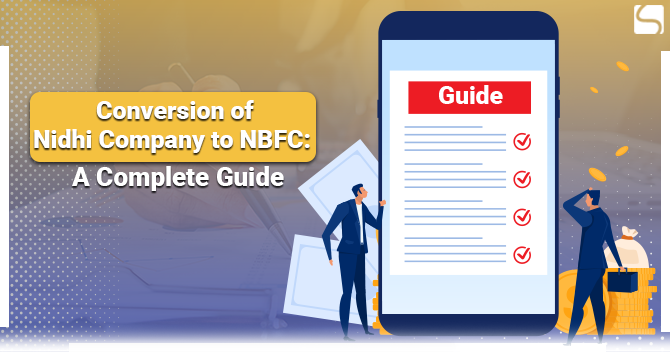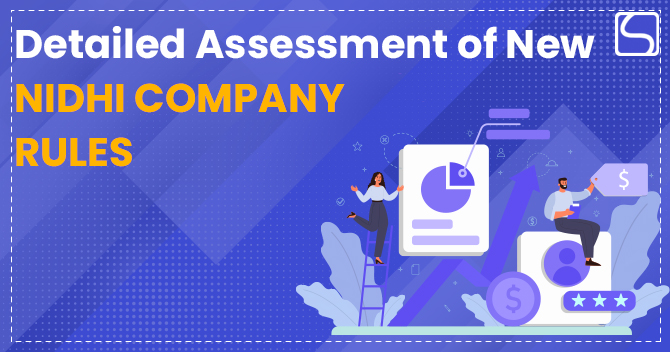Purpose and Applicability of New Nidhi Company Forms

Ganesh Nair | Updated: Aug 03, 2022 | Category: Nidhi Company
Section 406 of the companies Act 2013 specifies what a Nidhi company is. It is a type of NBFC that is created for the purposes of borrowing and lending between its members. It is incorporated to inculcate a habit of savings in its members. It is known by different names like the permanent fund, mutual benefit funds/company or simply benefits funds. This article will explain the purpose and applicability of New Nidhi Company Forms.
Table of Contents
Key features of a Nidhi Company
- Rule 6 of the Nidhi rules 2014 specify about specific points regarding the functioning of Nidhi Company:
- A Nidhi company should be involved in chit funds, insurance, leasing finance or security acquisition by any corporation.
- The company should not provide loans or accept deposits from people who are not its members.
- A Nidhi Company cannot issue any shares, debentures or debt instruments,
- Nidhi Companies are governed by the companies act, and the Nidhi rules 2014.
- Nidhi Company must get approval from the central government to operate.
- It must ensure that it has at least 200 members in the span of 12 months.
- It can charge interest of a maximum of 20% p.a.
- The company can offer a maximum interest of more than 2% above the rate offered by national banks.
- It can pay an interest of 12.5% (at present) on fixed deposits, recurring deposits and savings. This rate of interest should not exceed the maximum interest rate set by the RBI for NBFCs.
- Loans can only be extended against security. These securities can be gold, silver, fixed deposits, government securities, property etc.
- Nidhi Company must ensure that filing accounts, audits, and tax return is compulsory in the prescribed format.
Benefits of Nidhi Company
- Fewer Regulations: Nidhi companies fall under the purview of Nidhi Rules 2014. The central government focuses on the regulations relating to a Nidhi company. RBI seldom intervenes in the matters of Nidhi.
- Great option for Savings: Nidhi companies were created to foster habit saving amongst its members. The investment of the members helps a Nidhi to carry out its functions. Nidhi permits the act of lending and borrowing from its members only.
- Ease of Formation: Nidhi company requirements are very minimal. They require at least seven members, of which three should be appointed directors. A simple registration process and less paperwork are involved.
- Lower Risk: It has low risks as Nidhi companies can only lend out loans and accept deposits from its members only. The non-repayment of loans is very unlikely. Moreover, loans extended to the members are given at a very reasonable rate. These things make this one of the safest options
- Low capital requirement: Nidhi companies require a minimum capital of Rs. 10,00,000 post the 2022 amendment rules. This amount is significantly less compared to the large capital requirements needed to start other NBFC and financial institutions.
Now let’s have a look at Nidhi Company Forms and their purposes.
Nidhi company forms are their applicability:
- NDH-1 (Return of Statutory Compliance)
A Nidhi company within a span of 90 days after the completion of its first financial year post its incorporation. Must file for statutory compliance, and this shall be applicable to the second financial year as well as per the rules.
The following documents must be attached with Nidhi Company Form
NDH-1
- List of members with their PAN and address proof.
- Details of the amount received from each member
- Complete disclosure on break up of deposits must include Bank Name, Branch, A/c No.
- NDH-2 (Application for Extension of Time)
Nidhi Company can apply before 30 days from the end of the financial year to the Regional Director (RD) through form NDH-2 for an extension of time.
There are two situations when Nidhi Company Form NDH-2 can be filed these are:
- In case the company has failed to appoint 200 members within a year of incorporation.
- The company was unable to maintain a ratio of Net Owned Funds to deposits of 1:20.
The following documents must be attached with the Nidhi Company Form: NDH-2
- A copy of the board resolution
- A detailed application
- Last available audited financial statements
- List of members with their PAN and address proof.
- Details from the amount received from each member
- In-depth reasons and justification for the delay
- Important: This form needs to be verified by a practising professional.
- NDH-3 (Return for the Half-year Ended):
It is mandatory of all the NBFCs to file a half-yearly return with the Registrar through form NDH-3. This must be filed 30 days before the end of each half year.
The following things must be attached to Nidhi Company Form NDH-3:
- List of members with their PAN and address proof.
- Details of the amount accepted from each member.
- Copy of advertisement along with intimation provided to the Registrar.
- List of all members who have ceased to be part of Nidhi along with Pan details and address proof.
- NDH-4 (Application for Declaration as Nidhi Company and Updation of Nidhi Status)
New Nidhi Company:
- NDH-4 must be filed within 60 days after the completion of 1 Year from the date of incorporation.
- Or 60 days from the period of extension granted by the Regional Director.
Existing Nidhi Company:
- NDH-4 must be filed within a span of one year from the date of incorporation or 6 months after the introduction of Nidhi Rules 2019[1], (whichever is later).
Nidhi Company Form NDH-4 is filed for declaration of the entity as a Nidhi company and update its status.
Suppose a situation arises where the Nidhi does not comply with the regulations set forth by the requirements of NDH-4. In that case, it won’t be allowed to File FORM SH-7 (notice to the Registrar to alter the company’s share capital) and FORM PAS-3 (which is used for the return of Allotment).
- FORM AOC-4 and MGT-7 (Annual General Meeting)
The company must file the financial statements within 30 days of the Annual General Meeting via AOC-4 and File the annual return within 60 days of AGM in the E-form MGT-7.
Conclusion:
Even though Nidhi Company does have strict compliance norms due to a lack of RBI intervention, Nidhi Rules 2014 set regulations for all the Nidhi companies. The Nidhi Company Forms such as NDH-1,2,3,4 explain what all financial disclosure needs to be made by the company at what time. This article provides clarity to the companies regarding the purpose of these forms and their significance.
Read our Article:Detailed Assessment of New Nidhi Company Rules














